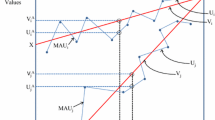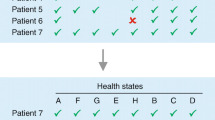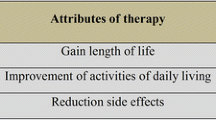Abstract
SummaryMulti-attribute utility theory. an extension of conventional utility theory, can be applied to model preference scores for health slates defined by multi-attribute health status classification systems. The type of preference independence among the attributes determines the type of preference function required: additive, multiplicative or multilinear. In addition, the type of measurement instrument used determines the type of preference score obtained: value or utility.
Multi-attribute utility theory has been applied to 2 recently developed multi-attribute health status classification systems the Health Utilities Index (HUI) Mark II and Mark III systems. Results are presented for the Mark system, and ongoing research is described for the Mark system. The theory is also discussed in the context of ocher well known multi-attribute systems.
The HUI system is an efficient method of determining a general public-based utility score for a specified health outcome or for the health status of an individual. In clinical populations, the scores can be used 10 provide a single summary measure of health-related quality of life. In cost-utility analyses, the scores can be used as quality weights for calculating quality-adjusted life years. In general populations, the measure can be used as quality weights for determining population health expectancy.
Similar content being viewed by others
References
Von Neumann J, Morgenstern O. Theory of games and economic behaviour. Princeton (NJ): Princeton UniversityPres, 1944
Luce RD, Raiffa H. Games and decisions. New York: Wiley. 1957
Raiffa H, Decision analysis: introductory lectures on urlder choices under uncertainty. Reading (MA): Addison-Wesley. 1968
Bell DE, Raiffa H, Tversky A. Desriptiye, normative,and prescriptive interactions in decision making. In: Bell DE, Raiffa H, Tversky A, editors. Decision making: descriptive, normative, and prescriptive interactions. Cambridge (MA): Cambridge University Press, 1988: 9–30
Howard RA. Decision analysis: practice and promise. Management Sci 1988; 34 (6): 679–95
Edwards W. Toward the demise of economic man and woman bottom lines from Santa Cruz. In: Edwards W, editor. Utility theories: measurement and management applications. Boston: Kluwer Academic, 1992: 2S3–67
Luce RD, Von Winterfeldt D. What common ground for descriptive, prescriptive, and normative utility theories? Management Sci 1994; 40 (2): 263–79
Keeney RL. Utility functions for multiattributed consequences. Management Sci 1972; 18 (5): 276–87
Keeney RL. Building models of values. Eur J Operations Res 1988; 37: 149–57
Farquhar PH. A fractional hypercube decomposition theorem for multiattribute utility functions. Operations Res 1975; 23 (5): 941–67
Farquhar PH. Pyramid and semicube decompositions of multiattribute utility functions. Operations Res 1976; 24 (2): 256–71
Farquhar PH. A survey of multiattribute utility theory and applications. Trends Managing Sci 1977; 6: 59–89
Keeney RL, Raiffa H. Decisions with mul1ip]e objectives: preferences and value tradeoffs. New York: Wiley, 1976
Feeny D, Furlong W, Boyle M, et al. Multi–attribute health StatuS classification systems: health utilities index. Pharomacoeconomics 1995; 7 (6): 490–S02
McNeil BJ, Weichselbaum R, Pauker SG. Speech and survival: tradeoffS between quality and quantity of life in laryngeal cancer. N Engl J Med 1981; 305 (17): 982–7
Boyd NF, Sutherland HJ, Ciampi A, et al. A comparison of methods of assessing voice quality in laryngeal cancer. In: Deber RA, Thompson GG. editors. Choices in health care:decision making and evaluation of effectiveness. Toronto: Departmentof Health Administration, University of Toronto. 1982: 141–4
Cadman D, Goldsmith CH. Development of an index of well being for handicapped children: final report to the Ontario Ministry of Health grant DM515. Hamilton (Ont.): Department of Clinical Epidemiology and Biostalislics, McMaster University. 1983
Boyle MH, Torrance GW. Developing multiattribute health indexes. Med Care 1984; 22 (11): 1045–57
Von Winterfeldt J, Edwards W. Decision analysis and behavioral research. Cambridge (MA): Cambridge University Press. 1986
Krantz DH, Luce RD, Suppes P, et al. Foundalions of measurement. Vol. 1. New York: Academic Press, 1971
Torrance GW. Social preferences for health States: an empirical evaluation of three measurement techniques. Soc Econ Planning Sci 1976; 10 (3): 129–36
Torrance GW, Boyle MH, Horwood SP. Application of multi–attribute utilitY theory to measure social preferences for healthstates. Operations Res 1982; 30 (6): 1043–69
Read JL, Quinn RJ, Berwick DM, et al. Preferences for health outcomes–comparisons of assessment methods. Med Decis for Making 1984; 4 (3): 315–29
Elstein A, Holzman GB, Ravitch MM, et al. Comparison of physicians’ decisions regarding estrogen replacement therapy for menopausal women and decisions derived from a decision analytic model. Am J Med 1986; 80: 246–58
Boyd NF, Sutherland HJ, Heasman KZ, et al. Whose utilities for decision analysis? Med Decis Making 1990; 10 (1): 58–67
Bass EB, Bergner M, Pitt H, et al. Comparison of patient utilities for gallstone treatments and related outcomes by rating scale and standard gamble techniques [abstract]. Med Decis Making 1991; 11 (4): 333
Patrick DL, Starks HE, Cain KC, et al. Measuring preferences for health states worse than death. Med Decis Making 1994; 14 (1): 9–18
Torrance GW. Utility approach to measuring health–related quality of life. J Chronic Dis 1987; 40 (6): 593–600
Guyatt GH, Feeny DH, Patrick, DL. Measuring health–related quality of life. Ann Intern Med 1993; 118 (8): 622–9
Patrick DL, Erickson PE. Health Status and health policy: quality of life in health care evaluation andresource allocation. New York: Oxford University Press, 1993
Drummond MF, Stoddart GL, Torrance GW. Methods for the economic evaluation of health care programmes. Oxford: Oxford University Press, 1987
Eisenberg JM. Clinical economics–a guide to the economic analysis of clinical practices. JAMA 1989; 262 (20): 2879–86
Torrance GW, Feeny D. Utilities and quality–adjusted life years. Int J Technol Assess Health Care; 1989: 5 (4): 559–75
Weinstein MC. Principles of cost–effective resource allocation in health care organizalions. Int J Technol Assess Health Care 1990; 6: 93–103
Laupacis A, Feeny DH, Detsky AS, et al. How attractive does a new techno]ogy have to be to warrant adoption and utilization? Tentative guidelines for using clinical and economic evaluations. Can Med Assoc J 1992; 146 (4): 473–81
Gafni A, Birch S. Guidelines for the adoption of new technologies:a prescription for uncontrolled growth in expenditures and how to avoid the problem. Can Med Assoc J 1993; 148 (6): 913–7
Naylor CD, Williams JI, Basinski A, et al. Technolo assessment and cost–effectiveness analysis: misguided guidelines? Can Med Assoc J 1993; 148 (6): 921–4
Laupacis A, Feeny D, Detsky AS, et al. Tentative guidelines for using clinical and economic evaluations revisited. Can Med Assoc J 1993; 148 (6): 927–9
Kaplan RM, Feeny DH, Revicki DA. Methods for assessing relative importance in preference based outcome measures. Qual Life Res 1993; 2 (6): 467–75
Canadian Coordinating Office for Health Technology Assessment. Guidelines for Ihe economic evaluation of pharmaceuticals:Canada. 1st ed. Ottawa: Canadian Coordinating Office for Health Technology Assessment. 1994
Garber AM, Phelps CE. Economic foundations of cost–effectiveness analysis. National Bureau of Economic Research Cambridge (MA). Working Paper No. 4164, 1992
Torrance GW. Health status index model: a unified mathematical view. Management Sci 1976; 22 (9): 990–1001
Wilkins R, Adams OB. Healthfulness of life. Montreal: The Institute for Research on Public Policy, 1983
Wilkins R, Adams OB. Measuring health. Policy Opt 1983; 4 (5); 28–31
Wilkins R, Adams OB. Health expectancy in Canada, late 1970’s: demographic, regional and social dimensions. Am J Public health 1983; 73 (9): 1073–80
Wolfson MC. A system of health statistics: toward a new conceptual framework for integrating health data. In: CIAR Population Health Working Paper No. 1. Toronto: Canadian Institute for Advanced Research, 1989
Berthelot J-M, Roberge R, Wolfson MC. The calculation of health–adjusted life expectancy for a Canadian province using a multi–attribute utility function: a first attempt. In: Robine JM, Mathers CD, Bone MR, et al., editors. Calculation of health expectancies: harmonization. consensus achieved and future perspectives. Vol. 226. Montpellier: Colloque INSERM/John Libbey Eurotexl Ltd., 1993: 161–72
World Bank. World development report 1993: inyesting in health: New York: Oxford University Press, 1993
Gold MR, Franks P, McCoy K. Condition weights for chronic diseases from a nationally representative sample [abstract]. Med Decis Making 1994: 14 (4): 431
Erickson P, Wilson R, Shannon I. Years of healthy life, statistical notes. No.7. Hyattsville (MD): National Center for Health Statistic, 1995
Torrance GW, Zhang Y, Feeny D, et al. Multi–attribute preference functions for a comprehensive health Status classification system. HamiltOn (Ont.): McMaster UniversitY, Centre for Health Economics and Policy Analysis. Working Paper No. 92–18, 1992
Boyle MH, Torrance GW, Sinclair JC, et al. Economic evaluaTion of neonatal intensive care of very–low–birth–weight infants. N Engl J Med 1983: 308: 1330–7
Feeny DH, Torrance GW, Goldsmith CH, et al. A multi–attribute approach to population health status. Proceedings of the Social Section, Alexandria (VA): American Statistical Association,. 1994: 161–6
Feeny D, Torrance GW, Goldsmith C, et al. A multi–attribute approach to population health status. Working Paper 94–5,Hamilton (Ont.): McMaster University, Centre for Health Economics and Policy Analysis, 1994
Kirk RE. Experimental design; procedures for the behavioural sciences. Belmont (CA): Brooks/Cole Publishing, 1968
Statistics Canada. Health status of Canadians: report of the 1991 general social survey. Cat, 11–612E.No.8. Ottawa; Statistics Canada. 1994
Kaplan RM, Anderson JP. A general health policy model: update and applications. Health Serv Res 1988; 23 (2): 203–35
Kaplan RM, Anderson JP. The general health policy model: an integrated approach. In: Spilker B. editor. Quality of life assessments in clinical trials. New York: Raven Press, 1990: 131–49
Euroqol Group. EuroQol–a new facility for the meaSurement of health–related quality of life. Health Policy 1990: 16: 199–208
Nord E. EuroQol: health–related quality of life meaSurement. Valuations of health states by the general public in Norway. Health Policy 1991; 18: 25–36
Essink-Bot ML, Stouthard MEA, Bonsel GJ. Generalizability of valuations on health States collected wilh the EuroQol questionnaire. Health Econ 1993; 2: 237–46
de Charoo F. The EuroQol: a measure of health–related quality on ife [brochure]. Rotterdam: Erasmus University, Centre for Health Policy and Law, 1994
Hadorn DC. Setting health care priorities in Oregon: cost–effectiveness meets the rule of rescue. JAMA 1991; 265 (17): 2218–25
Boyle M, Furlong W, Torrance GW, et al. Reliability of Ihe health ulilities index–Mark III used in the 1991 cycle 6 general social survey health questionnaire.Working paper No. 94–7. Hamilton (Ont.): McMaster University,Centre for Health Economics and Policy Analysis, 1994
Miller HW. Plan and operation ofthe Health and Nutrition Examination Survey,United States,1971–73. Vitlal and health statistics,series 1, no.10a,10b.DHEW publication no.(PHS)73–1310. Washington, DC: US Government Printing Office, 1977
Engel A, Murphy R, Maurer K, et al. Plan and operation oflhe NHANES I Augmentation Survey of adults 25–74 years. United States, 1974–75. Vital and health statistics,series 1,no. 14. DHEW publication no. (PHS) 78–1814. Washington,DC: US Government Printing Office, 1978
Cohen BB, Barbano HE, Cox CS, et al. Plan and operation of the NHANES I Epidemiologic Followup Study,1982–84. Vital and health Statitics, series 1, no.22.DHHS publication no. (PHS) 87–1324. Washington,DC: US Government Printing Office, 1987
Franks P, Gold M, Erickson P. Assessing the health of the nation: the predictive validity of a preference–based measure and self–rated health. Med Care. In press, 1987
Saigal S, Rosenbaum P, Stoskopf B, et al. Comprehensive assessment of the health status of extremely low birth weight children at eight years of age: comparison with a reference group. J Pediatr 1994; 125 (3): 411–7
Saigal S, Feeny D, Furlong W, et al. Comparison of the health related quality of life of extremely low birth weight children and a reference group of children at age eight years, J Pediatr 1994: 125 (3): 418–25
Furlong WJ, Torrance GW, Feeny DH. McMaster health utilities index: algorithm for determining Mark II/III health Status classification levels,health states and health state utility scores from 1992–10–20 self–administered health status questionnaire.Technical report. Hamilton (Ont.): McMaster University, 1995
Feeny DH, Leiper A, Barr RD, et al. The comprehensive assessment of health status in survivors of childhood cancer: application to high–risk acute lymphoblastic leukaemia, Br J Cancer 1993; 67: 1047–52
Barr RD, Feeny D, Furlong W, et al. A preference–based approach to health–related quality of life for children with cancer. Int J Pediatr Hematol Oncol 1995. In press
Barr RD, Pai MKR, Weitzman S. et al. A multi–attribute approach to health statuS measurement and clinical management–illustrated by an application to brain tumors in childhood. Int J Oncol 1994; 4: 639–48
Freund DA, Dittus RS, Fitsgerald J, et al. Assessing and improving outcomes: total knee replacement. Health Serv Res 1990; 25 (5): 723–6
Bellamy N, Buchanan WW, Goldsmith CH, et al. Validation study of WOMAC:a health status instrument for measuring clinically important patient relevant outcomes to antirheumatic drug therapy in patients with osteoarthritis of the hip or knee. J Rheumatol 1988; 15: 1833–40
Ware JE, Sherbourne CD. The MOS 36–item short form health survey (SF–36). Med Care 1992: 30 (6); 413–83
Torrance G, Rocchi A. Health Utilities Index in an oncology trial: a measure of health–related quality of life and basis for cost–utility analysis [abstract]. In: Tannock I, editOr. Clinical trials in oncology: improving their design and analysis, final program and abstracts: 1993 Oct 28–30: Toronto. Toronto: Ontario Cancer Institute/Princess Margaret Hospital,University of Toronto, 1993: 54
Rocchi A, Torrance G, Wheeler S, et al. Economic evaluation measuremnts in an oncology trial [abstract].In: Tannock I. editor. Clinical trials in oncology: improving their design and analysis. final program and abstracts: 1993 Oct 28–30:Toronto. Toronto: Ontario Cancer Institute Prinoess Margaret Hospital, University of Toronto, 1993: 55
Catlin G, Will P. The National Population Health Survey: highlights of initial developments. Health Reports (Statistics Canada, Catalogue 82–003) 1992; 4 (3); 313–9
Tambay J-L, Catlin G. Sample design 0f the National Population Health Survey. Health Reports (Statistics Canada, Catalogue 82–003). In press, 1992
Montigny G. The National longitudinal Survey of Chilmn (NLSC). Health Report Statistics Canada, Catalogue 82–003) 1993; 5 (3): 317–20
Tenenhouse A. The Canadian national osteoporosis study funded by the National Health Research and Development Program. Montreal: McGill University, 1994
Author information
Authors and Affiliations
Rights and permissions
About this article
Cite this article
Torrance, G.W., Furlong, W., Feeny, D. et al. Multi-Attribute Preference Functions. Pharmacoeconomics 7, 503–520 (1995). https://doi.org/10.2165/00019053-199507060-00005
Published:
Issue Date:
DOI: https://doi.org/10.2165/00019053-199507060-00005




